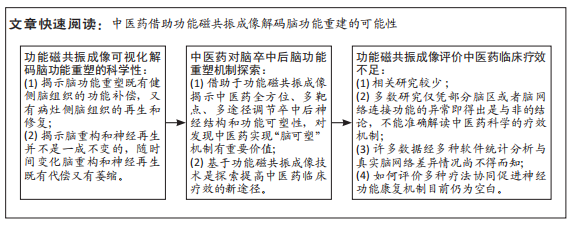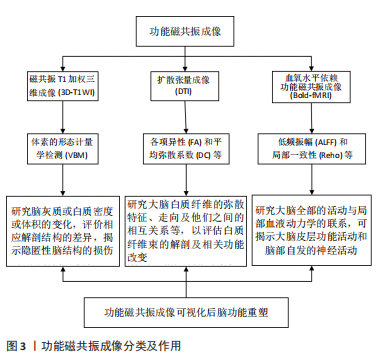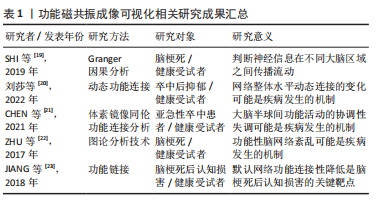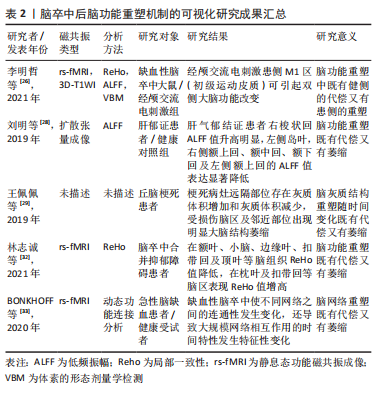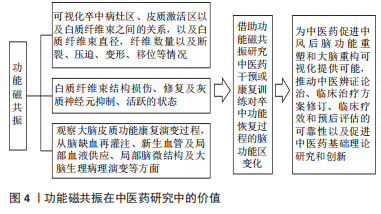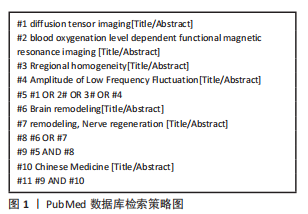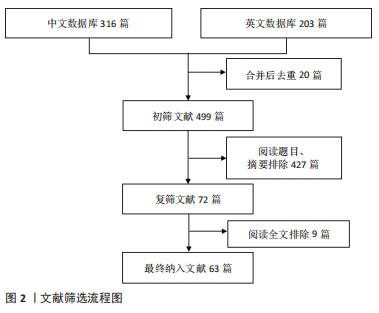[1] HIDALGO DE LA CRUZ M, VALSASINA P, SANGALLI F, et al. Dynamic functional connectivity in the main clinical phenotypes of multiple sclerosis. Brain Connect. 2021;11(8):678-690.
[2] STEWART JC, DEWANJEE P, TRAN G, et al. Role of corpus callosum integrity in arm function differs based on motor severity after stroke. Neuroimage Clin. 2017;14:641-647.
[3] 王东岩,何雷,宋晶,等.静息态功能磁共振技术在针灸脑科学领域中的应用研究进展[J].针灸临床杂志,2019,35(3):77-80.
[4] 金悦,林岚,熊敏,等.基于功能磁共振成像的认知储备在脑老化过程中的研究综述[J].医疗卫生装备,2022,43(4):82-87.
[5] 崔阳阳,梁怀彬,朱千,等.结合局部一致性和低频振幅探究躯体症状障碍患者大脑自发性活动的改变 [J].波谱学杂志,2022,39(1): 64-71.
[6] 曾繁勇,张志强,杨昉,等.急性缺血性卒中患者运动皮质激活及功能重组的功能磁共振成像研究[J].中国现代神经疾病杂志,2017, 17(12):883-890.
[7] 郝清,丁思萱,李冬雪,等.应用扩散张量成像技术对急性缺血性卒中机体功能障碍与锥体束损伤程度的相关性研究[J].磁共振成像,2021,12(1):3-8, 20.
[8] 史静,董慧珠,李伟荣,等.弥散张量成像在评价青年脑卒中后失语症预后中的作用[J].中国药物与临床,2019,19(13):2185-2187.
[9] CHEN X, ZHANG H, ZOU Y. A functional magnetic resonance imaging study on the effect of acupuncture at GB34 (Yanglingquan) on motor-related network in hemiplegic patients. Brain Res. 2015;1601:64-72.
[10] PACHECO-CASTILHO AC, MIRANDA RPC, NORBERTO AMQ, et al. Dysphagia is a strong predictor of death and functional dependence at three months post-stroke. Arq Neuropsiquiatr. 2022;80(5):462-468.
[11] 徐涵,吴霜.卒中后吞咽神经功能代偿与重塑的机制研究进展[J].中国康复,2020,35(4):212-216.
[12] KANG BX, MA J, SHEN J, et al. Altered brain activity in end-stage knee osteoarthritis revealed by resting-state functional magnetic resonance imaging. Brain Behav. 2022;12(1):e2479.
[13] 陈芷涵,王容,李郁欣,等.功能磁共振成像动态脑功能连接网络分析方法及其在脑疾病中的应用[J].中国临床神经科学,2020,28(5): 571-578.
[14] CORDANI C, VALSASINA P, PREZIOSA P, et al. Action observation training promotes motor improvement and modulates functional network dynamic connectivity in multiple sclerosis. Mult Scler. 2021;27(1): 139-146.
[15] YUAN YS, XU HL, LIU ZD, et al. Brain functional remodeling caused by sciatic nerve transposition repair in rats identified by multiple-model resting-state blood oxygenation level-dependent functional magnetic resonance imaging analysis. Neural Regen Res. 2022;17(2):418-426.
[16] 欧芳元,黄俊浩,易小琦,等.静息态fMRI比率低频振幅技术在针刺治疗脑梗死的研究[J].中国医学计算机成像杂志,2019,25(3): 236-241.
[17] TSAI YH, YUAN R, HUANG YC, et al. Disruption of brain connectivity in acute stroke patients with early impairment in consciousness. Front Psychol. 2014;4:956.
[18] ALLEGRA M, FAVARETTO C, METCALF N, et al. Stroke-related alterations in inter-areal communication. Neuroimage Clin. 2021;32:102812.
[19] SHI Y, LIU W, LIU R, et al. Investigation of the emotional network in depression after stroke: a study of multivariate Granger causality analysis of fMRI data. J Affect Disord. 2019;249:35-44.
[20] 刘莎,张训,黄癸卯,等.利用静息态功能磁共振成像探讨抑郁症患者注意力网络动态连接的整体变化[J].磁共振成像,2022,13(6): 40-44.
[21] CHEN J, SUN D, SHI Y, et al. Altered static and dynamic voxel-mirrored homotopic connectivity in subacute stroke patients: a resting-state fMRI study. Brain Imaging Behav. 2021;15(1):389-400.
[22] ZHU Y, BAI L, LIANG P, et al. Disrupted brain connectivity networks in acute ischemic stroke patients. Brain Imaging Behav. 2017;11(2):444-453.
[23] JIANG L, GENG W, CHEN H, et al. Decreased functional connectivity within the default-mode network in acute brainstem ischemic stroke. Eur J Radiol. 2018;105:221-226.
[24] ZENDEHROUH E, SENDI MSE, SUI J, et al. Aberrant functional network connectivity transition probability in major depressive disorder. Annu Int Conf IEEE Eng Med Biol Soc. 2020;2020:1493-1496.
[25] SEILER A, NöTH U, HOK P, et al. Multiparametric quantitative MRI in neurological diseases. Front Neurol. 2021;12:640239.
[26] 李明哲,魏雷,张英杰,等.经颅交流电刺激对缺血性脑卒中大鼠rs-fMRI的影响[J].中国康复医学杂志,2021,36(3):260-266.
[27] MALANDRAKI GA, SUTTON BP, PERLMAN AL, et al. Age-related differences in laterality of cortical activations in swallowing. Dysphagia. 2010;25(3):238-249.
[28] 刘明,熊航,陈云翔,等.肝气郁结证脑白质磁共振扩散张量成像研究[J].医学研究杂志,2019,48(10):44-47.
[29] 王佩佩,李琼阁,单艺,等.丘脑梗死患者灰质体积改变与运动功能相关性的随访研究[J].医学影像学杂志,2019,29(3):345-349.
[30] 蒋宇,黄小华,刘念.基于体素的形态学分析在缺血性脑卒中的研究进展[J].国际医学放射学杂志,2021,44(2):157-160.
[31] 李大年,郑燕婷,刘玉洁,等.肝郁证患者局部脑区神经活动变化静息态功能磁共振成像研究[J].中国中医药信息杂志,2021,28(12): 88-92.
[32] 林志诚,游咏梅,王君,等.脑卒中后吞咽障碍患者下丘脑功能连接和全脑各向异性的磁共振成像研究[J].中国康复理论与实践, 2021,27(5):504-509.
[33] BONKHOFF AK, ESPINOZA FA, GAZULA H, et al. Acute ischaemic stroke alters the brain’s preference for distinct dynamic connectivity states. Brain. 2020;143(5):1525-1540.
[34] 郭晟,周承志.中医活血化瘀法治疗急慢性心脑血管疾病的异与同[J].中国医药导报,2020,17(19):140-143.
[35] 杨洋.基于MRA及血管超声缺血性中风中医证候与脑供血动脉病变的相关性分析研究[D].泸州:西南医科大学,2017.
[36] 辛铭正,曹晓岚,孙灵芝.基于络病理论探讨分水岭脑梗死的病理机制及中医药治疗进展[J].实用心脑肺血管病杂志,2021,29(3): 128-131.
[37] 田金洲,盛彤,刘峘,等.卒中后患者认知损害的脑影像学改变与中医证候的关系[J].中医杂志,2004,45(2):132-134.
[38] 毕丽丽.中风复元合剂治疗分水岭脑梗死临床观察[J].中国中医急症,2016,25(12):2366-2368.
[39] 张梅奎.益脑通络胶囊对缺血性中风神经细胞保护作用的实验研究[D].北京:北京中医药大学,2003.
[40] 张路遥.206例急性缺血性脑卒中患者头颅MRI表现与中医病证相关性初探[D].北京:北京中医药大学,2016.
[41] WEI D, XIE D, LI H, et al. The positive effects of Xueshuan Xinmai tablets on brain functional connectivity in acute ischemic stroke: a placebo controlled randomized trial. Sci Rep. 2017;7(1):15244.
[42] 任珊.结合功能磁共振评价联合三七总皂苷对中风病患者神经重塑的研究[D].北京:北京中医药大学,2017.
[43] 朱丹,刘永康,厉励,等.基于fMRI技术观察中西医结合治疗对急性缺血性脑卒中默认网络的影响[J].南京中医药大学学报,2021, 37(6):871-877.
[44] 张晶. 丹参多酚酸治疗急性脑梗死静息态功能磁共振的临床研究[D].长春:吉林大学,2018.
[45] GAO L, HUANG P, DONG Z, et al. Modified Xiaoyaosan (MXYS) exerts anti-depressive effects by rectifying the brain blood oxygen level-dependent fmri signals and improving hippocampal neurogenesis in mice. Front Pharmacol. 2018;9:1098.
[46] 胡培铅.抑郁症患者脑功能改变及药物治疗抑郁症的静息态功能磁共振研究[D].广州:南方医科大学,2016.
[47] 谭赛,方继良,黄世敬,等.开心解郁方治疗血管性抑郁症脑机制fMRI初步研究[J].中国中西医结合影像学杂志,2017,15(3):261-266,273.
[48] 张涛军.健脾补肾活血方结合运动疗法对脑梗死患者缺血区血液循环的影响[D].郑州:河南中医药大学,2016.
[49] 吕冰峰.灯盏花素注射液治疗缺血半暗带脑梗死临床观察[J].河南职工医学院学报,2014,26(3):268-269.
[50] 张金生.微环境、神经干细胞、脑衰老与补肾化瘀生新[J].中华中医药学刊,2021,39(11):5-8.
[51] 张金生,张宝霞,刘雪曼.补肾化瘀生新方优化缺血缺氧微环境对间充质干细胞旁分泌效应及分化率的影响[J].中华中医药学刊, 2021,39(9):9-16, 259.
[52] 李威,张音,蒋亚文.运用DTI分析针灸治疗脑卒中疗效25例[J].内蒙古中医药,2014,33(35):97-98.
[53] 朱丹,刘永康,赵宇栋,等.基于比率低频振幅探讨疏血通注射液联合西医常规疗法对急性缺血性脑卒中的疗效及机制研究[J].中国中医药信息杂志,2022,29(5):112-117.
[54] 许建阳,王发强,王宏,等.针刺太冲穴对fMRI脑功能成像的研究[C]//第八次全国中西医结合影像学术交流大会全国中西医结合影像学研究进展学习班论文集. 2005:35-37.
[55] 赵波沣,胡元明,陈树平.功能磁共振成像对针刺联合中医药治疗脑梗死疗效评价[J].中国医学装备,2017,14(7):72-75.
[56] 苏丽缘.针刺对脑卒中后吞咽障碍患者脑功能影响的观察[D].广州:广州中医药大学,2015.
[57] ZHU B, WANG Y, ZHANG G, et al. Acupuncture at KI3 in healthy volunteers induces specific cortical functional activity: an fMRI study. BMC Complement Altern Med. 2015;15:361.
[58] LIN CS, WU CY, WANG DH, et al. Brain signatures associated with swallowing efficiency in older people. Exp Gerontol. 2019;115:1-8.
[59] ZHANG J, JIANG H, WU F, et al. Neuroprotective effects of hesperetin in regulating microglia polarization after ischemic stroke by inhibiting TLR4/NF-B pathway. J Healthc Eng. 2021;2021:9938874.
[60] 倪雯沁,陈月蓉,徐赟赟,等. 基于功能磁共振成像技术探讨针灸治疗焦虑抑郁的中枢机制[J]. 针刺研究,2022,47(8):728-733.
[61] 陈栩铤,顾旭东,姚云海,等.单侧高频重复经颅磁刺激对脑卒中吞咽障碍及功能性磁共振成像的影响[J].中华物理医学与康复杂志,2021,43(12):1105-1109.
[62] PLUTA R, JANUSZEWSKI S, CZUCZWAR SJ. Neuroinflammation in post-ischemic neurodegeneration of the brain: friend, foe, or both? Int J Mol Sci. 2021;22(9):4405.
[63] TAO T, LIU M, CHEN M, et al. Natural medicine in neuroprotection for ischemic stroke: challenges and prospective. Pharmacol Ther. 2020; 216:107695. |
